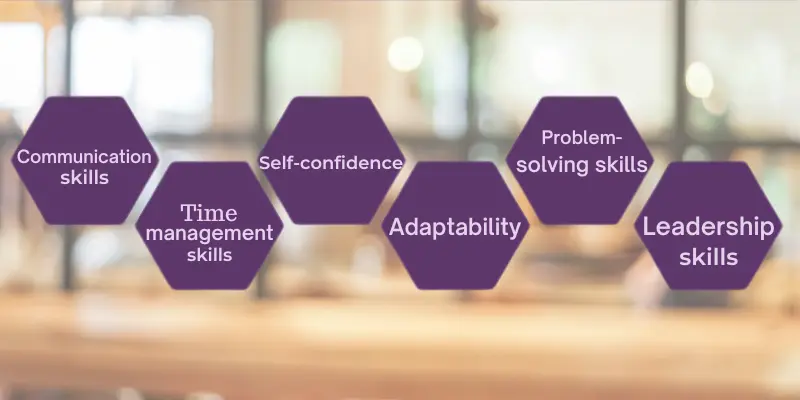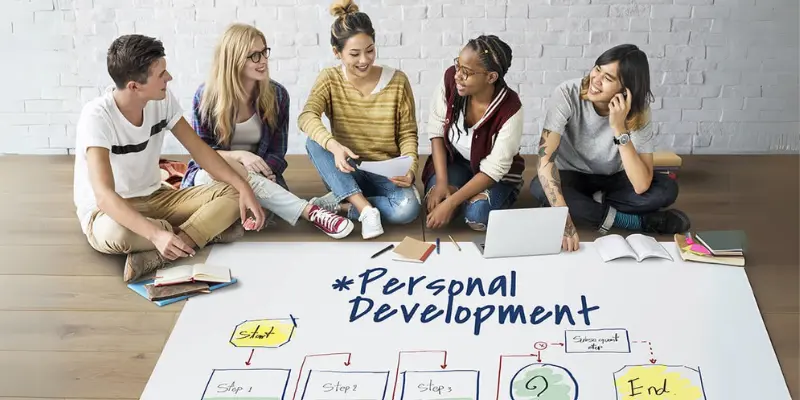The Ultimate Guide to Personal Development Training for Employees
Published: 11 Aug 2025
Have you ever considered how personal development training can help your team perform better? Personal development training teaches essential skills, including leadership, time management, and effective communication. This enables employees to advance in their careers and collaborate more effectively.
Tanveer, an expert in personal development, will show you how this kind of training can change your workplace. You’ll learn why it’s important, find helpful tips, and see how to check if it’s working.
Think of this guide as your map to employee growth. It offers simple tips on how to grow your career or assist your team in improving. Ready to start? Let’s go!
What is Personal Development Training for Employees?
Personal development training shows employees how to learn new skills, grow, and work better. It gives them what they need to succeed and advance in their careers while building a workplace where learning and growth are essential.
This training teaches how to talk to others, solve problems, lead a team, and learn new skills. These abilities permit employees to do their jobs well and strengthen the company.
Types of Personal Development Training
Personal development training comes in various forms to meet different employee needs. Here’s a quick overview:
- Soft Skills Training: Enables employees to work well with others by improving communication, teamwork, and understanding feelings. It’s like making the teamwork engine run smoothly.
- Hard Skills Training: Employees learn specific tools or technical skills, like how to use new software or earn certifications. It’s like adding more tools to their toolbox to allow them to succeed.
- Leadership Development: Leadership training prepares employees to become leaders by teaching them how to guide a team and make good decisions. It’s like planting seeds to grow future leaders.
- Time Management and Productivity Training: This training teaches employees to plan their time and focus on essential tasks. It’s like giving them a map to guide them through their work without stress.

Why is Personal Development Training Important?
Personal development training helps workers and businesses grow together. It builds skills, boosts confidence, and creates a happy workplace, a win-win situation for everyone.
1. Benefits for Employees
- Better Job Happiness and Career Growth: Training lets workers learn new skills and feel confident about their future. As a result, they enjoy their jobs more and grow in their careers.
- Skills for Moving Up: Like athletes practice to get better, workers can improve key skills like leadership and problem-solving to take on more prominent roles.
- More Confidence and Self-Knowledge: Training allows workers to understand their strengths and feel ready to handle challenges.
The only way to do great work is to love what you do. Steve Jobs
2. Benefits for Employers
- Better Work Results: Trained workers are more intelligent and focused, which helps the company run smoothly.
- Loyal Workers: Workers who feel supported stay longer, saving time and money on hiring.
- Positive Workplace Vibes: Focusing on growth fosters an environment where everyone learns and improves.
Personal development training helps both workers and businesses succeed. Start now to see real growth and lasting success.

How to Implement Personal Development Training in Your Organization
Starting personal development training in your organization is like caring for a garden. You determine what needs attention, provide the right tools, and check how things grow.
Here’s how you can do it step by step:
Step 1: Find Out What Employees Need
First, determine where your team needs support and what skills they want to improve.
- Ask Questions: Use surveys or quizzes to determine what skills employees want to work on. This will allow you to understand what areas need attention.
- Talk to Managers and Employees: Have conversations with managers and employees to get their ideas on what’s working and what’s not. It’s like making a plan before you start.
Step 2: Choose the Right Training
Once you know what’s needed, choose the best ways to facilitate employees’ growth.
- Pick Programs That Fit: Choose training that works for company goals and employees’ needs.
- Consider Different Options: Depending on what works best for your team, you can offer in-house training, online courses, or workshops.
Step 3: Set Clear Goals
Make sure everyone knows what to expect from the training.
- Set Goals You Can Measure: Have clear goals, like improving communication or leadership skills.
- Align with Employee Goals: Link training to employees’ career goals to motivate them.
Step 4: Check Progress
Make sure the training is working and helping employees improve.
- Check Regularly: Have check-ins to see if employees are making progress.
- Give Feedback: Offer feedback to allow employees to improve and change the training.
Personal development training grows over time. These steps permit employees and the company to improve and reach their full potential.
What we fear doing most is usually what we most need to do. Tim Ferriss
Common Barriers to Personal Development and How to Overcome Them
Personal development training is essential, but a few challenges can get in the way, like not having enough time, employees resisting change, and not having enough money.
Let’s look at how to overcome these challenges and create a workplace where everyone can grow:
1. Lack of Time for Training
Finding time for training can be challenging in a busy work environment. But with the right approach, it’s still possible.
- How to Make Time for Training: Think of personal development as an investment. You don’t need hours; 15 to 30 minutes daily can make a big difference over time.
- How to Fit Training Into Daily Work: You can use short learning sessions during breaks or add small lessons to team meetings. This way, training becomes part of the regular workday, not something extra.
2. Employee Resistance to Change
Sometimes, employees may not be excited about learning new skills or methods. Overcoming this is essential for growth.
- How to Get Employees on Board: Discuss how training will help them and the company. Involve them in the decision-making process so they can see the value.
- Creating a Learning Culture: Instead of thinking of training as a task, make it about continuous learning and growth. Recognize progress and encourage everyone to keep learning. It’s like planting seeds; when you nurture them, they’ll grow.
Your life does not get better by chance, it gets better by change.Jim Rohn
3. Budget Constraints
Training can be expensive, but it doesn’t always have to be costly. There are many low-cost options.
- Affordable Training Options: There are free or low-cost options, such as online workshops, webinars, and sharing knowledge within the company. You can even create mentoring programs where employees learn from each other.
- Using Free Online Resources: Websites like Coursera, edX, and YouTube offer free or low-cost resources to help employees develop new skills without incurring significant expenses.
By facing these challenges head-on, you can create a skilled, motivated, and engaged workforce. Planning and the right attitude are key to helping everyone grow and succeed.
How to Take Charge of Your Personal Growth
Personal development enables you to improve your life and career. Taking charge allows you to acquire new skills, open doors to opportunities, and achieve your goals.
Here are some simple tips to help you get started:
1. Know Your Strengths and Weaknesses
Begin by understanding what you’re good at and what areas need improvement. This will help you focus on improving the areas that need improvement.
- Use Tools: Try a personal SWOT analysis (Strengths, Weaknesses, Opportunities, Threats).
- Ask for Feedback: Get advice from coworkers, mentors, or supervisors.
- Take Online Tests: Tools like StrengthsFinder or MBTI can show you your talents.
2. Seek Out Learning Opportunities
Learning is the key to growing. There are many ways to improve your skills.
- Take Online Courses: Websites like Coursera and Udemy have great lessons.
- Read Books: Books offer valuable tips and ideas.
- Attend Workshops: Hands-on training teaches skills you can use right away.

3. Build Connections
Networking and mentorship can help you learn from others and grow more quickly.
- Network: Join groups or events to connect with like-minded individuals in your field.
- Find a Mentor: A mentor can guide you and give helpful advice.
4. Set Goals for Growth
Goals provide direction and enable you to track your progress.
- Make SMART Goals: Goals should be Specific, Measurable, Achievable, Relevant, and Time-bound.
- Break Big Goals into Small Steps: Focus on one or two things at a time.
- Track Your Progress: Check your progress regularly and celebrate small wins.
5. Stay Motivated
Continue to push yourself to grow by staying inspired.
- Reward Yourself: Celebrate your achievements.
- Stay Positive: Read inspiring content and surround yourself with supportive people.
By following these tips, you can take control of your personal growth and build a brighter future.
An investment in knowledge pays the best interest. Benjamin Franklin
Tools and Resources for Personal Development
Personal development is a journey; having the right tools can guide you to growth. Whether you want to improve your skills or advance in your career, many resources are available to support your development.
Let’s explore some of the best tools for personal development:
1. Top Online Platforms for Learning
Here are some great online platforms where you can learn new skills.
- LinkedIn Learning: It offers courses on leadership, communication, and project management. You can learn at your own pace and earn certificates upon completion.
- Coursera: This platform partners with top universities to offer business, technology, and data science courses. It’s perfect for structured learning.
- Udemy: Udemy offers affordable courses on many topics. It’s easy to use and great for both beginners and professionals.
- Skillshare: Skillshare focuses on creative skills like marketing and design. It has interactive classes that can help you become more innovative.
2. Helpful Books for Personal Growth
Books can teach you a lot about how to be more successful. Here are a few great books to read:
- The 7 Habits of Highly Effective People by Stephen Covey: This book teaches essential habits that can guide you to success, such as being proactive and managing your time effectively.
- Atomic Habits by James Clear explains how small habits can lead to significant improvements over time. It gives practical tips on how to build good habits.
- Drive: The Surprising Truth About What Motivates Us by Daniel H. Pink: This book discusses what motivates people and how to use motivation to succeed.
3. In-House vs. External Training
Companies have to choose between in-house (internal) and external training. Let’s look at both options:
| In-House Training | External Training |
|---|---|
| Pros: It fits the company’s needs and culture, and is easier to follow up on. | Pros: Bring fresh ideas and expert knowledge; flexible courses and certifications. |
| Cons: It can lack new ideas and require more time and resources. | Cons: It can be expensive and may not align with the company’s culture. |
Both in-house and external training have benefits. The best choice depends on your company or team’s needs. Mixing both can provide a great learning experience for everyone.
| Interesting Facts |
|---|
|
Conclusion
Personal development training isn’t just about gaining skills; it’s about applying them. Don’t wait for the perfect moment, start today! Whether you’re interested in personal growth or helping your team, the key is to begin. Your future self will thank you, so take that first step and unlock your greatest potential.
In my journey, I’ve realized that self-development isn’t just about learning, it’s about practicing what you know. Training programs, books, and mentorships are valuable, but real growth happens when you apply new skills daily. Small actions, such as improving communication or managing time more effectively, can lead to long-term success.
So, what will you do today? Take a moment to reflect, choose one habit to improve, and commit to making daily progress. Your best version is waiting; go after it!
FAQs
Find answers to common questions below:
Training helps employees perform their jobs more effectively, stay with the organization longer, and collaborate more effectively. Companies that invest in training have happier teams and better results. Over time, the benefits are worth more than the cost.
Motivate your team with these ideas:
- Make it Personal: Offer training that aligns with their goals and job requirements.
- Reward Participation: Give recognition or small rewards to those who join.
- Set an Example: When leaders participate in training, others are more likely to follow suit.
Small budgets don’t mean you can’t provide good training!
- Use Free Resources: Find free trials or webinars online.
- Share Knowledge: Ask skilled employees to teach others.
- Partner Locally: Work with nearby schools or training centres for discounts.
Beginners need to start with simple, helpful skills like:
- Communication: Learn to communicate effectively with others.
- Time Management: Learn how to plan and finish tasks on time.
- Problem-Solving: Learn ways to fix issues and make good decisions.
Check these to see success:
- Skill Tests: See if employees are learning new skills.
- Feedback: Ask employees for their thoughts on the training.
- Work Results: Look for better productivity and happier workers.
Training helps everyone grow, like planting seeds for success. You can create a team that loves learning and improving with small steps and regular checks.
If this helped you even 1%, smile – it means everything.
(No email needed. No follow required. Just smile.)

- Be Respectful
- Stay Relevant
- Stay Positive
- True Feedback
- Encourage Discussion
- Avoid Spamming
- No Fake News
- Don't Copy-Paste
- No Personal Attacks

- Be Respectful
- Stay Relevant
- Stay Positive
- True Feedback
- Encourage Discussion
- Avoid Spamming
- No Fake News
- Don't Copy-Paste
- No Personal Attacks







